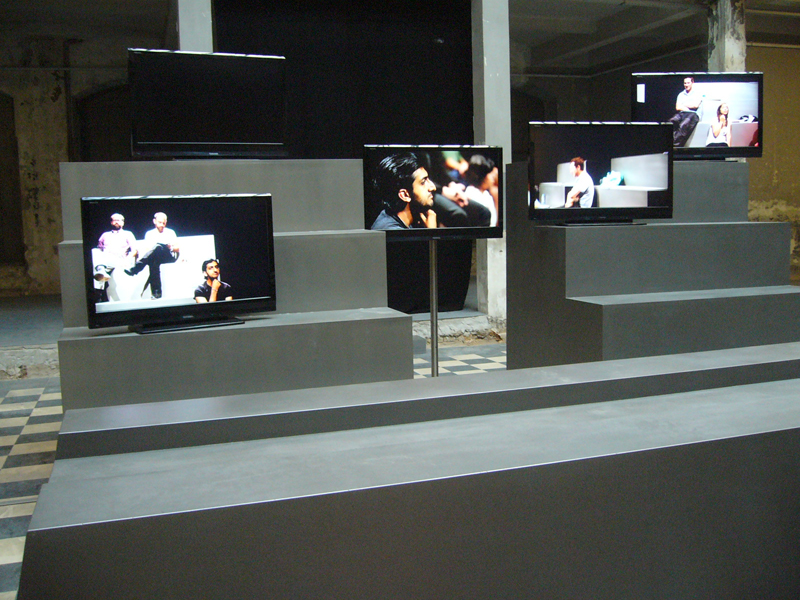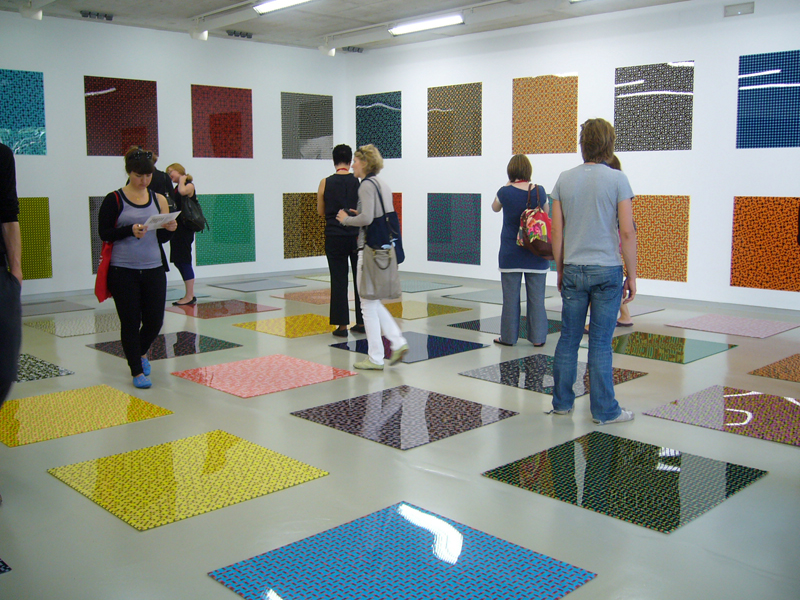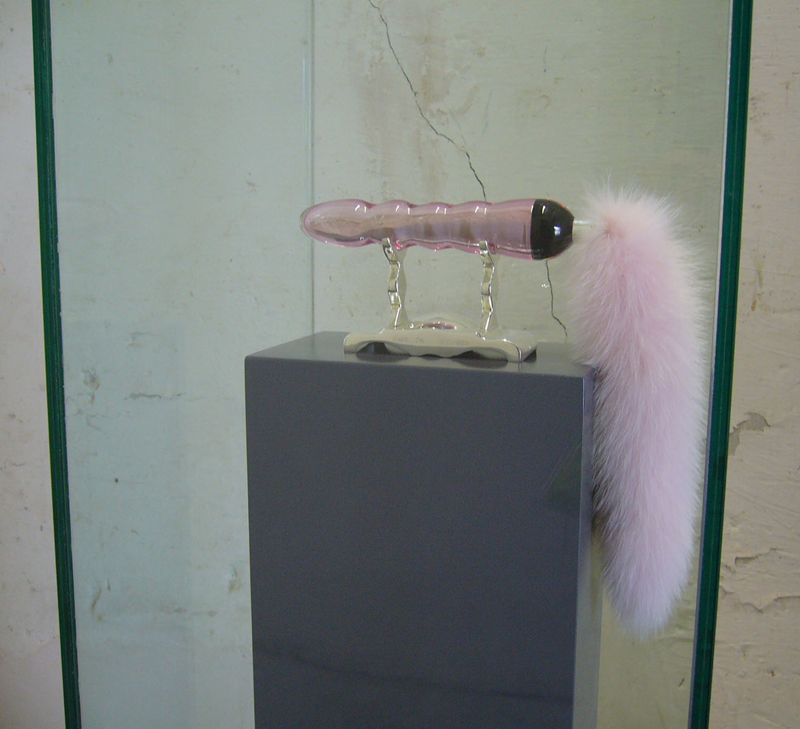Manifesta 8 (Exhib. Review)
Manifesta 8, Murcia and Cartagena, Spain; 15 venues plus various channels of mass media, October 9, 2010–January 9, 2011
Curatorial collectives: Alexandria Contemporary Arts Forum (ACAF), Chamber of Public Secrets (CPS), and tranzit.org
 The memorable night party scene in Federico Fellini’s La Dolce Vita was inspired by a real life event at the birthday party of a millionaire’s fiancé in a Trastevere restaurant. Anita Ekberg, one of the invited celebrities, kicked off her shoes and with her spaghetti straps hanging loose, performed an impassioned barefoot cha-cha. The year was 1958, so the gesture came across as audacious even for Rome’s decadent café society. However, her dance also profoundly impressed both male and female viewers—as the photographs taken at the party, which were subsequently widely circulated in the print media, suggest. A young and aspiring Turkish belly dancer wanted to outdo Ekberg and improvised a striptease. Now, this act may have been even bolder than Anitas, but the rich and beautiful were watching it with tacit contempt. Clearly, the elite have always had finely tuned, albeit unwritten, rules even for such trifling acts as dancing while intoxicated.
The memorable night party scene in Federico Fellini’s La Dolce Vita was inspired by a real life event at the birthday party of a millionaire’s fiancé in a Trastevere restaurant. Anita Ekberg, one of the invited celebrities, kicked off her shoes and with her spaghetti straps hanging loose, performed an impassioned barefoot cha-cha. The year was 1958, so the gesture came across as audacious even for Rome’s decadent café society. However, her dance also profoundly impressed both male and female viewers—as the photographs taken at the party, which were subsequently widely circulated in the print media, suggest. A young and aspiring Turkish belly dancer wanted to outdo Ekberg and improvised a striptease. Now, this act may have been even bolder than Anitas, but the rich and beautiful were watching it with tacit contempt. Clearly, the elite have always had finely tuned, albeit unwritten, rules even for such trifling acts as dancing while intoxicated.
 An exhibition on Fellini’s cinematic oeuvre in Madrid’s Caixa Forum runs parallel with Manifesta 8 and presents the scene described above. It offers an uncanny analogy between the miscalculating dancer, oblivious to the intricate code of conduct, and the curatorial efforts of this year’s Manifesta to force an individualist and egocentric sort of art practice into a collaborative and critical dialogue. This is not to deny that biennials can be innovative in that regard.WHW’s 2009 Istanbul Biennale has already provided an example of such a curatorial mandate. We are well aware of the critical fetish in contemporary art praxis but the supersession of a mere fetishistic pseudo-criticality requires that artists, and especially curators, follow up on both the theoretical and pragmatic consequences of the critical insights to which they claim to subscribe.
An exhibition on Fellini’s cinematic oeuvre in Madrid’s Caixa Forum runs parallel with Manifesta 8 and presents the scene described above. It offers an uncanny analogy between the miscalculating dancer, oblivious to the intricate code of conduct, and the curatorial efforts of this year’s Manifesta to force an individualist and egocentric sort of art practice into a collaborative and critical dialogue. This is not to deny that biennials can be innovative in that regard.WHW’s 2009 Istanbul Biennale has already provided an example of such a curatorial mandate. We are well aware of the critical fetish in contemporary art praxis but the supersession of a mere fetishistic pseudo-criticality requires that artists, and especially curators, follow up on both the theoretical and pragmatic consequences of the critical insights to which they claim to subscribe.
 Curatorial innovation and dialogue are keywords for Manifesta 8 and are reflected in the presence of three curatorial groups, each in its turn consisting of several people, and each with members based in different countries. Such a fragmented team cannot produce a coherent show either in its concept or realization, yet this is something one can live without. After all, we might simply look for the way in which the three teams respond, each in their own way, to the exhibition’s call to open a dialogue between the region of Murcia and Northern Africa.
Curatorial innovation and dialogue are keywords for Manifesta 8 and are reflected in the presence of three curatorial groups, each in its turn consisting of several people, and each with members based in different countries. Such a fragmented team cannot produce a coherent show either in its concept or realization, yet this is something one can live without. After all, we might simply look for the way in which the three teams respond, each in their own way, to the exhibition’s call to open a dialogue between the region of Murcia and Northern Africa.
While the curatorial statements do differ in some important ways (also in relation to what I termed pseudo-criticality above), the works on display show a disheartening homogeneity of media, artistic strategy, and ways of expression. The kinds of genres that we encounter are long-winded videos, subtitled or voiced-over; ragged installations; audio-visual traces of meetings between artists and their collaborators; or compilations of material (dubbed “research”). There are only very occasional objects and drawings but instead lots of A4-sized sheets, xeroxed copies and printed material. All this adds up to create a retinal desert; Joseph Kosuth would be delighted.
However, aesthetic affect is just one kind of allure that many of the presented works and projects suppress. One does not have to be an ardent follower of Danto to insist on a kind of aesthetic pleasure that results from conceptual coherence and the details of artistic execution, and to appreciate such internal beauty in works of art. Instead, theoretical propositions are too often and easily translated into artistic enunciations that simply lack (rather than consciously refute) any aspiration to ”internal beauty.” Amidst such offerings is Kajsa Dahlberg’s neatly installed postcard collection, Nikolaus Schletterer’s color and patterned, shiny digital prints stand out for their sheer visual quality, and so does Jasper Rigole’s two-room installation for its well articulated concept and execution. By contrast, some creditable video works (like Amnesialand by Stefanos Tsivopoulos or Melanie Gilligans’s four part drama about the financial crisis) are flattened in the enormous flood of moving images offered for view due to what must seem like ill concieved installation decisions.
 However, the repressed returns. Sensuality that is denied on the level of visual perception strikes back as a quest for the sensational. The contemporary art crowd that is already used to congregating in abandonded buildings, this time conquered a dramatic new location, a recently closed prison. A group of visually impaired artists are engaged to run the world’s first non-visual residency program, or to feature as groundbreaking scientific evidence. A certain Prof. John M. Kennedy presents the blind artist Esref Armagan to prove that the ability to draw develops in blind people just as it does in those with sight. This discovery should, we are told, call for ”the reconstruction of art history.” This project was installed in a Manifesta venue exploring the constructedness of visual information. While the notion of a blind painter undoubtedly fits such a thematic focus, it is tempting to take it further and mull over just what the construction, and the visual discursive verification of a persona (through a website, a Wikipedia entry, a TV reportage and the like) would require in the information age.
However, the repressed returns. Sensuality that is denied on the level of visual perception strikes back as a quest for the sensational. The contemporary art crowd that is already used to congregating in abandonded buildings, this time conquered a dramatic new location, a recently closed prison. A group of visually impaired artists are engaged to run the world’s first non-visual residency program, or to feature as groundbreaking scientific evidence. A certain Prof. John M. Kennedy presents the blind artist Esref Armagan to prove that the ability to draw develops in blind people just as it does in those with sight. This discovery should, we are told, call for ”the reconstruction of art history.” This project was installed in a Manifesta venue exploring the constructedness of visual information. While the notion of a blind painter undoubtedly fits such a thematic focus, it is tempting to take it further and mull over just what the construction, and the visual discursive verification of a persona (through a website, a Wikipedia entry, a TV reportage and the like) would require in the information age.
One can go into two directions from here. The first is to trust in the existence of Mr. Armagan. Even in this case, listening carefully to Esref’s narrative, there is a notable manipulation in the presented evidence. That is, that he was actually taught by the sighted about perspective and color. The same superficiality and sensationality of both the visual and textual information provided, lead one to the second possibility, which forces the visitor to expect an impending exposure of a hoax, an artworld edition of the Sokal affair. Sokal’s account of his own hoax smoothly translates into the context of the art biennial: submit a project documentation to test the intellectual rigor of both the organizers and the audience, and see if a high profile international event would accept a work “liberally salted with nonsense, if it (a) sounded good and (b) flattered the editors’ [here: curators’] ideological preconceptions.” It is not out of cynicism that I wish the second version to be true. It is out of a craving for highly conceptual, finely tuned and consequentially executed art projects, of which we saw so few at Manifesta 8.




